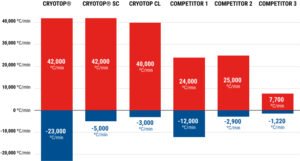Overview
Cryotop® allows you to achieve the best clinical results. Its unparalleled survival rates for oocytes and embryos, at every stage of development, have contributed to bringing hundreds of thousands of healthy babies into the world since its creation.
Cryotop® is a vitrification device consisting of a fine strip of transparent film attached to a plastic handle resistant to liquid nitrogen.
Its design allows the loading of specimens for vitrification with a minimum volume (0.1 µl), providing the best Cooling and Warming Rates on the market (-23,000ºC/minute and 42,000ºC/minute respectively) which, in turn, lead to the best survival rates.

The revolutionary device by Kitazato is applied in more than 2,500,000 clinical cases for cryopreservation of oocytes and embryos annually, obtaining excellent results in over 115 countries and 3,000 assisted reproduction centers.


Key Features
- Wider sheet for an easy loading of the specimens on the straw
- Thin strip to allow high temperature exposure to specimens during vitrification and thawing
- Diamond tip for an easy insertion into the cover straw
- Identification marks to define the side where specimens should be loaded for quick location of the cryopreserved samples during thawing
- Allows up to 4 specimens to be loaded per device
Highest Cooling and Warming Rates on the Market
Cooling and warming rates are essential parameters for the success of vitrification and thawing processes. These parameters, especially the warming ones, have a huge impact in specimens survival rates.
The Cryotop® vitrification device ensures a very high cooling and warming rates resulting into better survival and live birth rates.
This is achieved thanks to the design of the Cryotop®, with its characteristic thin strip, the use of small volumes surrounding the specimen, and the design of the vitrification and thawing protocols that allow excellent heat exchanges between the specimen and the LN2/Warming Media.




